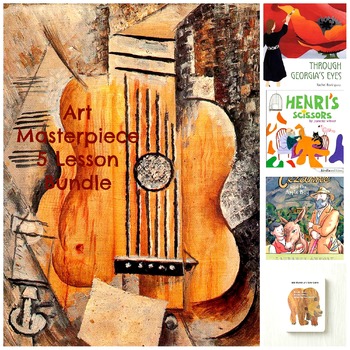Art Lessons 5 Lesson Bundle Matisse Picasso Carle O'Keefe Cezanne History ELA
- Zip
Products in this Bundle (5)
Description
Are you looking for a fun and engaging way to introduce your students to the world of art? Our art lesson bundle featuring works by Matisse, Picasso, Carle, O'Keefe, and Cezanne is just what you need!
In this lesson bundle, we'll guide your students through some of the most iconic works of art of the 20th century.
They'll learn how Matisse used bold colors and simple shapes to create his vibrant Fish Bowl painting, how Picasso challenged the conventions of perspective and representation with his Guitar sculpture, how Carle's Frog captures the playful spirit of his children's books, how O'Keefe celebrated the beauty of nature with her stunning Flowers paintings, and how Cezanne explored the possibilities of color and form in his Still Life Tables and Fruit.
Here are four ways you can incorporate this lesson bundle into your elementary classroom:
- Art History: Use the works of these iconic artists to teach your students about different art movements and styles, and how art reflects the social and cultural context of its time.
- Science: Use O'Keefe's Flowers to teach your students about the anatomy and biology of plants, and how different colors and patterns can help them attract pollinators.
- Writing: Use the artworks as inspiration for creative writing activities, encouraging your students to write poems or stories inspired by the themes and images in the paintings.
- Art: Use the techniques and styles of these artists to teach your students about color mixing, composition, and other fundamental art techniques.
Our easy-to-follow lesson plans make it a breeze to lead your students through these fun and engaging art activities, even if you're not an experienced art teacher.
-Matisse: Fish Bowl
-Picasso:Guitar
-Carle: Frog
-O'Keefe: Flowers
-Cezanne: Still Life Tables and Fruit
CLICK HERE to view my freebies
CLICK HERE to view my DRAWING LESSONS
CLICK HERE to view my ART WITH THE MASTERS ART LESSONS
CLICK HERE to view my CONTEMPORARY ART LESSONS
CLICK HERE to view my ART LESSONS THAT COMPLIMENT POPULAR BOOKS
CLICK HERE to view my SELF ESTEEM PROJECTS
CLICK HERE to view my CLASS MURAL IDEAS
CLICK HERE to view my FUN ART FOLK ART LESSONS
CLICK HERE to view my 3 BUNDLED LESSONS
CLICK HERE to view my 5 BUNDLED LESSONS
Make sure to click the GREEN STAR near my store name so that you can stay in touch with my store. I create new lessons every week.


